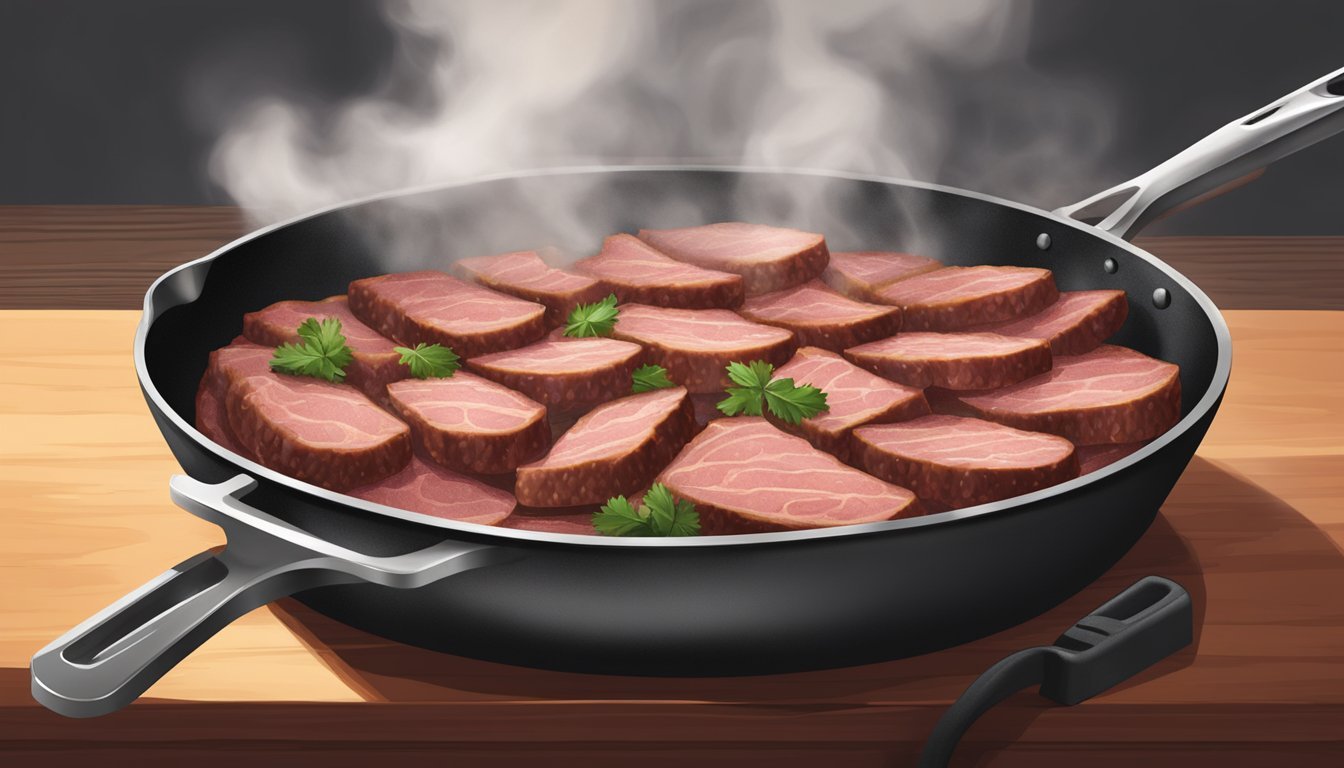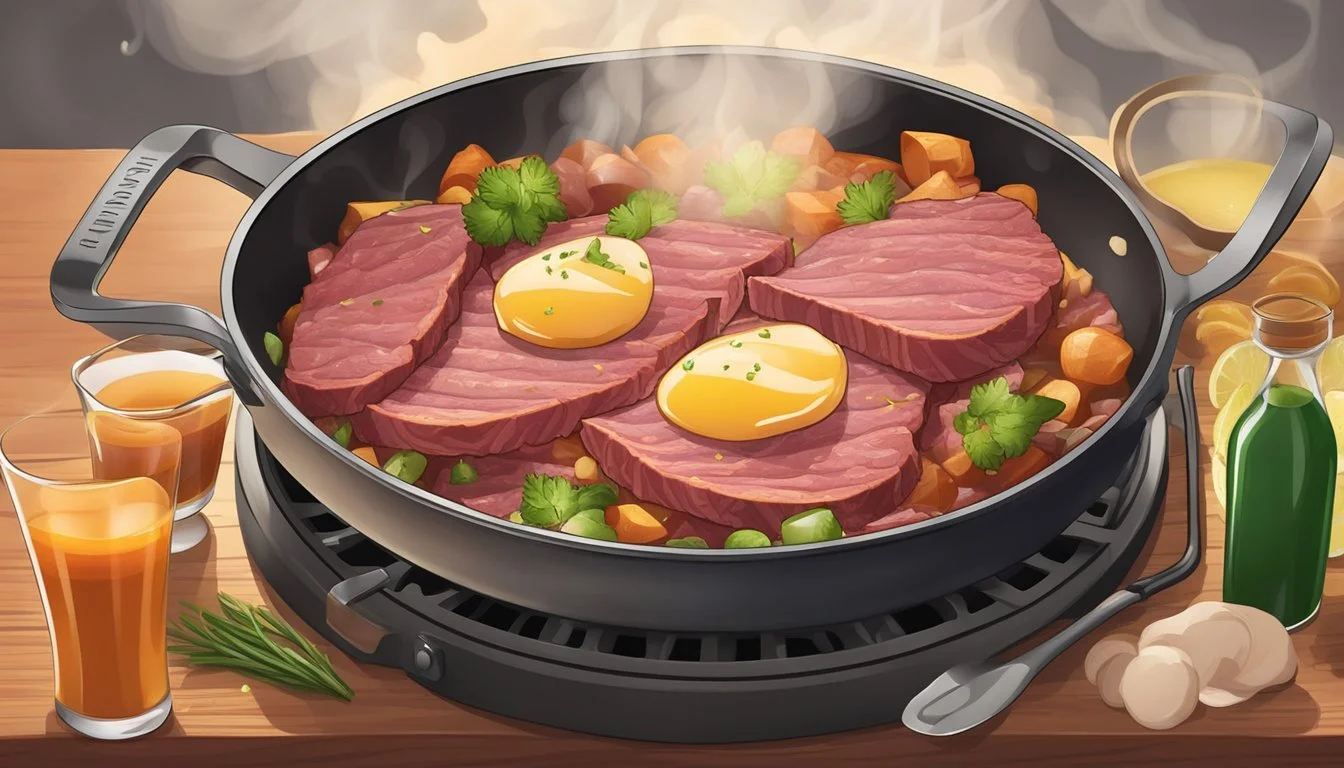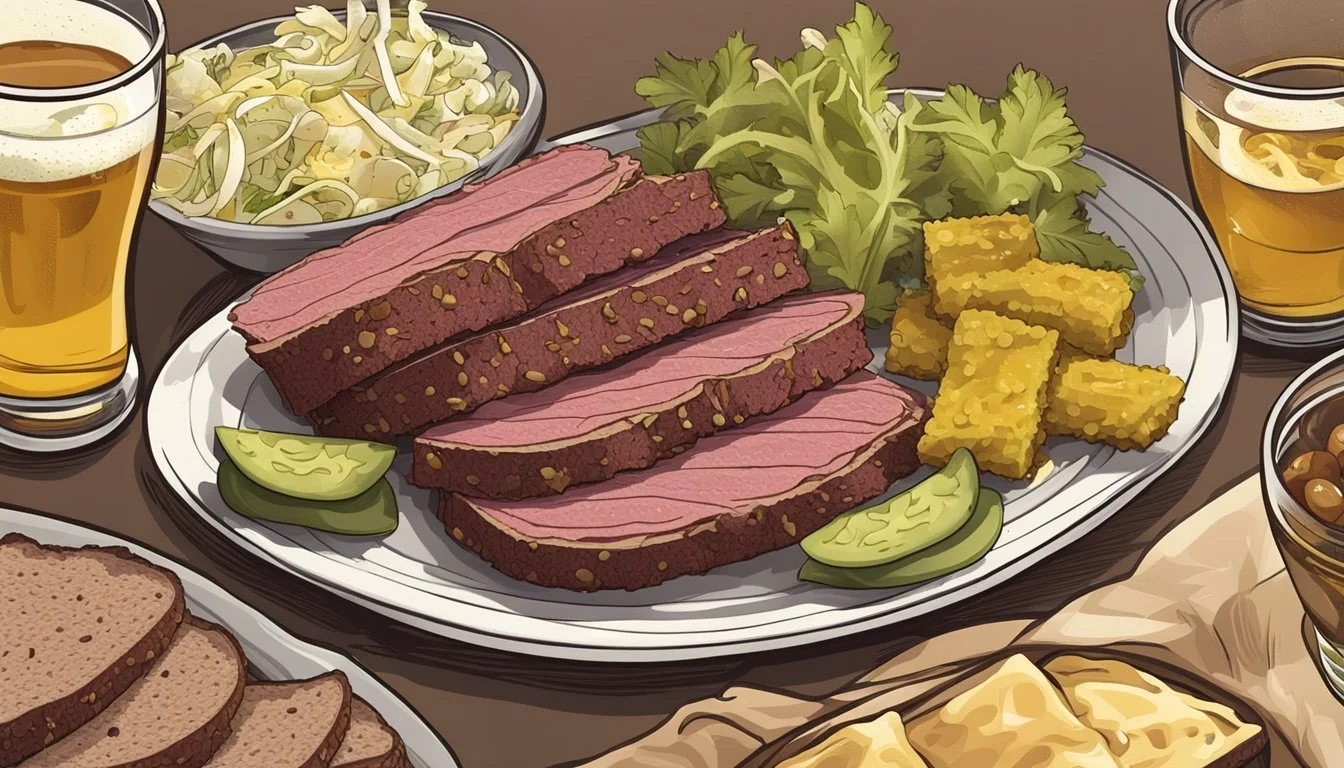Smoked Corned Beef
A Flavorful Twist on a Classic Dish
Smoked homemade corned beef (What wine goes well with beef?) offers a delightful twist on the traditional boiled corned beef commonly found in Irish-American cuisine or store-bought corned beef. This version imbues this cut of tougher meat with a rich smoky flavor while maintaining the corned beef's signature tenderness and savory taste. It typically involves taking a brisket, which has been cured or pickled in a seasoned brine, and then slow-cooking it with wood smoke.
The process begins with either a store-bought prepared corned beef brisket or one that has been cured at home. The brisket is coated with a spice rub that might include black pepper, coriander, paprika, garlic, and onion powder (how long does onion powder last?), which complements the natural flavors of the meat. Cooking the meat at low temperatures in a smoker ensures that the brisket absorbs the smoke's nuanced flavors, leading to a mouth-watering result that can be enjoyed in a variety of dishes.
Whether the meat is served with vegetables like cabbage or utilized within sandwiches, smoked corned beef provides a unique take on the classic corned beef flavor profile. Careful preparation and adherence to smoking techniques are essential to achieving the perfect balance of smoke and seasoning. This method of preparation is growing in popularity, making smoked corned beef a versatile ingredient that enhances the culinary experience all year round, not just on St. Patrick’s Day.
Now before you fire up your pellet grills at home, it's important to understand the nuances of smoked corned beef, what separates it from store-bought corned beef, and how smoked corned beef from scratch is way better for you.
Understanding Smoked Corned Beef
Smoked corned beef elevates traditional corned beef by introducing a rich smokiness to the already flavorful brisket. This section explores its origins, the curing process, and how smoking differentiates it from the standard preparation method.
Origins and Basics
Smoked corned beef is a variation of corned beef, which is a brisket cut, cured in a seasoned brine. The term "corned" comes from the large grains or "corns" of salt historically used in the curing process. It is a staple dish of Irish origin but has been adopted widely, especially for celebrations like St. Patrick’s Day. Today, the process of smoking adds a contemporary twist to this traditional meat.
Curing Process
Corned beef is created by curing a brisket, cuts of meat from the lower chest of beef, in a brine solution typically composed of:
Water
Salt
Sugar
Pickling spices (how long does pickling spice last?)/Spice packet (such as mustard seeds (how long do mustard seeds last?), bay leaves, and peppercorns)
Sodium nitrite (for preservation and color)
This curing process can take several days to weeks, and it's crucial for achieving the distinct pink hue and tender texture of corned beef.
Skip the lines and order your salt, sugar, pickling spice, mustard seed, and sodium nitrite online for a stress-free shopping experience!
Smoked Vs. Traditional Corned Beef
While traditional corned beef is often boiled or slow-cooked, smoking introduces an additional element:
Flavor: The smoke imparts a savory layer that complements the spiciness of the pickling cure.
Texture: Smoking the corned beef provides a firmer bark on the meat's exterior while preserving its tenderness.
Choosing between smoked and traditional corned beef usually comes down to personal preference and the desired end result, whether it's a traditional plate with cabbage or a flavorful, smoked brisket for sandwiches and BBQ platters.
Selecting the Meat
When preparing smoked corned beef, the choice of meat is crucial for flavor and texture. One must consider the cut of the brisket and its intrinsic qualities to ensure a delicious outcome.
Brisket Choices
The brisket is the cut of choice for corned beef. It comes in two primary cuts:
Point: The point cut is thicker, marbled with more fat, and known for its rich flavor.
Flat: The beef brisket flat cut is leaner, with less fat and a more uniform shape, making it easier to slice.
For smoking, a balance of meat and fat is desirable as the fat imparts flavor and helps keep the meat moist during the long cooking process. Also, when prepping the meat, be sure to remove any membrane layer because these are hard to digest.
Quality and Characteristics
When selecting a beef brisket for smoking, one should look for:
Marbling: Visible streaks of fat within the muscle contribute to tenderness and flavor.
Color: A fresh brisket should have a bright red hue, indicating good quality.
Fat Cap: A layer of fat on one side that should be thick enough to retain moisture but not so thick that it prevents flavor penetration.
One should choose a corned beef brisket that has been properly cured in a brine solution. The brine contains salts and spices that not only flavor the meat but also tenderize it. The curing process is essential for what differentiates corned beef brisket from regular beef brisket.
Preparation Techniques
Before smoking corned beef, it's crucial to properly prepare the meat through brining, seasoning, and additional preparation steps to ensure the perfect balance of flavors and texture.
Brining Essentials
To create the foundational flavor and texture of corned beef, the brine is critical. A typical brine contains water, salt, sugar, and a mixture of spices that can include garlic powder, (how long does garlic powder last?) onion powder, coriander seeds (how long do coriander seeds last?), and others. The beef should be submerged in the brine and kept in the refrigerator for at least a week, with larger cuts requiring more time. After, brining, the brisket is usually washed with water to get rid of the excess liquid from the brine.
Save time and effort by ordering garlic powder, onion powder, and coriander seeds online!
Seasoning and Spice Rub
After the brine, a spice rub adds a complex layer of flavor. The rub ingredients is composed of coriander, garlic powder, and onion powder. Liberally spread the rub onto the surface of the meat; ensuring an even coating. The rub should coat the entire exterior of the brisket, creating a flavorful crust that will caramelize during smoking.
Meat Preparation Steps
Properly preparing the meat for smoking involves a few key steps. Firstly, rinse the corned beef under cold water to remove any excess salt. Some chefs recommend soaking the meat in cold water for 1-2 hours to further reduce saltiness and rehydrate the beef. After soaking, pat the corned beef dry with paper towels. Ensure the meat is at room temperature before smoking to promote even cooking.
Cooking Process
In smoking corned beef, precise temperature control during the cooking time and proper wrapping for rest are crucial steps that ensure the meat is flavorful and tender.
Temperature and Smoke Control
To achieve the optimal smoky flavor and tenderness, one must maintain a consistent temperature within the smoker throughout the smoking time. The internal meat temperature of the meat is a critical metric, where corned beef should reach around 204 degrees Fahrenheit for the desired doneness. Monitoring the smoker's temperature is also essential; a range of 250 to 275 degrees Fahrenheit is usually recommended for an even cook. Quality wood chips contribute to the flavor profile of the smoked meat. Utilizing a reliable meat thermometer can help monitor the internal temperature accurately to prevent overcooking.
For the most extensive selection, I suggest buying a meat thermometer online!
Wrapping and Resting
Once the internal temperature nears completion, wrapping the corned beef in aluminum foil or placing it in an aluminum foil pan can help retain moisture and distribute heat evenly. This step is commonly referred to as the 'Texas crutch' and aids in tenderizing the brisket. After reaching the target internal temperature, it's important to let the meat rest. Resting allows the juices to redistribute throughout the brisket, ensuring a succulent bite. The wrapped brisket should rest in a pot or insulated container for at least an hour before slicing to serve.
Serving and Pairing
When presenting smoked corned beef, one must consider the best ways to slice and serve the meat, as well as which side dishes to pair it with for a harmonious meal experience.
Slicing and Presentation
Properly slicing smoked corned beef is crucial for optimal texture and taste. One should always slice the meat against the grain to ensure tenderness. For presentation, thin, even slices showcase the meat's smoky crust and juicy interior. They can arrange these slices neatly on a platter, perhaps garnished with parsley, to highlight the corned beef's inviting appearance.
Accompaniments and Side Dishes
Pairing smoked corned beef with the right side dishes enhances the overall dining experience. The robust, salty flavor of the meat pairs well with the following:
Cabbage: A classic complement, cabbage can be served as a crisp, Asian-inspired slaw or sautéed until tender for a warm side.
Potatoes: Potato gratin, with its creamy texture and golden-brown crust, balances the smokiness of the beef.
Carrots and Glazed Carrots: Offering both a sweet and earthy profile, carrots can be glazed for extra flavor or roasted to maintain their natural sweetness.
Corned Beef Tacos (What wine goes well with beef tacos?): For a creative twist, one can use slices of smoked corned beef as a delicious filling for tacos, adding a smoky depth to each bite.
By considering these accompaniments, one ensures a meal that complements the central flavors without overpowering them.
Smoked Corned Beef Recipe
Take corned beef to new heights of flavor with this recipe for deliciously smoky and tender homemade Smoked Corned Beef. Perfectly cooked brisket that has been cured in a traditional corned beef brine gets a boost of smokiness and spice from a flavorful dry rub.
Ingredients:
3-4 lb. corned beef brisket
1⁄4 cup brown sugar
2 tablespoon coarse black pepper
2 teaspoon garlic powder
2 teaspoon onion powder
1 teaspoon smoked paprika (how long does smoked paprika last?)
1⁄2 tsp cayenne pepper
Instructions:
Rinse off the excess salt from the brined piece of meat under cold water and pat dry with paper towels. Trim off any excess fat.
Make a rub by mixing together brown sugar, black pepper, garlic powder, onion powder, smoked paprika and cayenne pepper. A generous layer of spices is a must but make sure it's evenly distributed.
Preheat smoker to 225°F using preferred wood chips. Place brisket fat-side up, laying the beef brisket flat on the grill grates, and the smoking time sweet spot should be for about 1 hour per pound.
Using a meat thermometer, the internal temperature should be at 195°F. Once reached, the smoking process for the brisket is done.
Remove brisket from smoker and tightly wrap in aluminum foil. Let beef rest rest for 30-60 minutes after the cook time.
Carefully unwrap brisket and slice against the grain into 1⁄4 inch thick slices.
Serve warm with side dishes like roasted potatoes, braised cabbage, or glazed carrots. Garnish with parsley.
Tips:
Use oak, hickory, or apple wood chips for optimal mild wood smoke flavor.
Monitor temperature closely to prevent overcooking.
Letting brisket rest is crucial for retaining moisture.
Slice brisket as needed, refrigerating leftovers in an airtight container.
Enjoy this tender and smoky homemade smoked corned beef!
Variations and Related Dishes
The journey of smoked corned beef doesn't end at the dinner table. Creative culinary twists can transform this classic into various delectable dishes, from the transformation into rich, flavorful pastrami to innovative meals crafted from leftovers.
Smoked Corned Beef to Pastrami
Turning smoked corned beef brisket into pastrami involves additional steps of seasoning and smoking the already cooked corned beef. One coats the brisket in a blend of coriander, black pepper, and other spices, and then smokes it again to achieve the signature crust and richly spiced flavor of pastrami. Typically, the pastrami is then steamed before serving, which makes it exceptionally tender. A classic pastrami recipe may call for ingredients like garlic and brown sugar, and the use of beef stock in the steaming process to infuse even more flavor.
Creative Leftover Ideas
Leftover smoked corned beef can be the star ingredient in several dishes, giving meals a savory and smoky kick. Here are a couple of ways to repurpose leftovers:
Corned Beef Hash: Dice the corned beef and sauté with potatoes, onions, (What wine goes well with onions?) and herbs for a hearty breakfast.
Corned Beef in Sandwiches: Thinly sliced corned beef can be stacked on rye with mustard, making for a delicious sandwich reminiscent of a deli classic.
Each variation showcases the versatility of corned beef and celebrates the culinary potential of this traditional cured meat.




